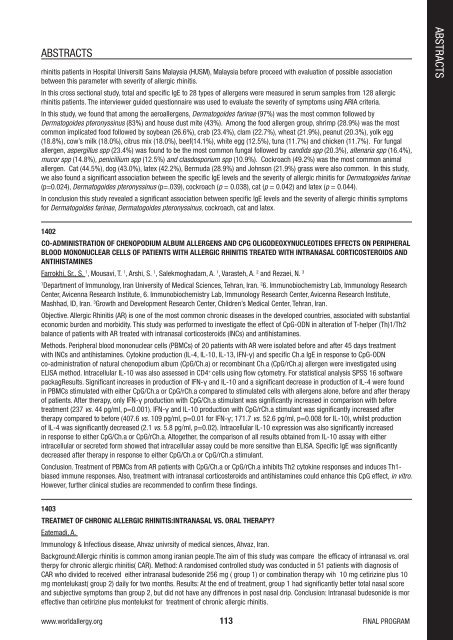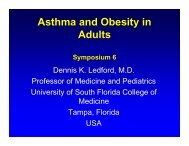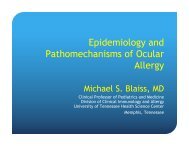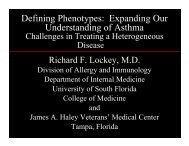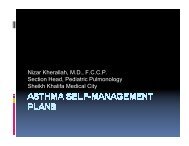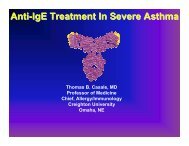Dubai Final-v20.indd - World Allergy Organization
Dubai Final-v20.indd - World Allergy Organization
Dubai Final-v20.indd - World Allergy Organization
Create successful ePaper yourself
Turn your PDF publications into a flip-book with our unique Google optimized e-Paper software.
ABstrACts<br />
rhinitis patients in Hospital Universiti sains malaysia (HUsm), malaysia before proceed with evaluation of possible association<br />
between this parameter with severity of allergic rhinitis.<br />
in this cross sectional study, total and specific igE to 28 types of allergens were measured in serum samples from 128 allergic<br />
rhinitis patients. the interviewer guided questionnaire was used to evaluate the severity of symptoms using AriA criteria.<br />
in this study, we found that among the aeroallergens, Dermatogoides farinae (97%) was the most common followed by<br />
Dermatogoides pteronyssinus (83%) and house dust mite (43%). Among the food allergen group, shrimp (28.9%) was the most<br />
common implicated food followed by soybean (26.6%), crab (23.4%), clam (22.7%), wheat (21.9%), peanut (20.3%), yolk egg<br />
(18.8%), cow’s milk (18.0%), citrus mix (18.0%), beef(14.1%), white egg (12.5%), tuna (11.7%) and chicken (11.7%). For fungal<br />
allergen, aspergillus spp (23.4%) was found to be the most common fungal followed by candida spp (20.3%), altenaria spp (16.4%),<br />
mucor spp (14.8%), penicillium spp (12.5%) and clasdosporium spp (10.9%). Cockroach (49.2%) was the most common animal<br />
allergen. Cat (44.5%), dog (43.0%), latex (42.2%), Bermuda (28.9%) and Johnson (21.9%) grass were also common. in this study,<br />
we also found a significant association between the specific igE levels and the severity of allergic rhinitis for Dermatogoides farinae<br />
(p=0.024), Dermatogoides pteronyssinus (p=.039), cockroach (p = 0.038), cat (p = 0.042) and latex (p = 0.044).<br />
in conclusion this study revealed a significant association between specific igE levels and the severity of allergic rhinitis symptoms<br />
for Dermatogoides farinae, Dermatogoides pteronyssinus, cockroach, cat and latex.<br />
1402<br />
Co-aDminiSTraTion oF CHEnoPoDiUm alBUm allErgEnS anD CPg oligoDEoXYnUClEoTiDES EFFECTS on PEriPHEral<br />
BlooD mononUClEar CEllS oF PaTiEnTS WiTH allErgiC rHiniTiS TrEaTED WiTH inTranaSal CorTiCoSTEroiDS anD<br />
anTiHiSTaminES<br />
Farrokhi, sr., s. 1 , mousavi, t. 1 , Arshi, s. 1 , salekmoghadam, A. 1 , Varasteh, A. 2 and rezaei, n. 3<br />
1 2 Department of immunology, iran University of medical sciences, tehran, iran. 6. immunobiochemistry lab, immunology research<br />
Center, Avicenna research institute, 6. immunobiochemistry lab, immunology research Center, Avicenna research institute,<br />
mashhad, iD, iran. 3growth and Development research Center, Children’s medical Center, tehran, iran.<br />
Objective. Allergic rhinitis (Ar) is one of the most common chronic diseases in the developed countries, associated with substantial<br />
economic burden and morbidity. this study was performed to investigate the effect of Cpg-ODn in alteration of t-helper (th)1/th2<br />
balance of patients with Ar treated with intranasal corticosteroids (inCs) and antihistamines.<br />
methods. Peripheral blood mononuclear cells (PBmCs) of 20 patients with Ar were isolated before and after 45 days treatment<br />
with inCs and antihistamines. Cytokine production (il-4, il-10, il-13, iFn-γ) and specific Ch.a igE in response to Cpg-ODn<br />
co-administration of natural chenopodium album (Cpg/Ch.a) or recombinant Ch.a (Cpg/rCh.a) allergen were investigated using<br />
ElisA method. intracellular il-10 was also assessed in CD4 + cells using flow cytometry. For statistical analysis sPss 16 software<br />
packagresults. significant increases in production of iFn-γ and il-10 and a significant decrease in production of il-4 were found<br />
in PBmCs stimulated with either Cpg/Ch.a or Cpg/rCh.a compared to stimulated cells with allergens alone, before and after therapy<br />
of patients. After therapy, only iFn-γ production with Cpg/Ch.a stimulant was significantly increased in comparison with before<br />
treatment (237 vs. 44 pg/ml, p=0.001). iFn-γ and il-10 production with Cpg/rCh.a stimulant was significantly increased after<br />
therapy compared to before (407.6 vs. 109 pg/ml, p=0.01 for iFn-γ; 171.7 vs. 52.6 pg/ml, p=0.008 for il-10), whilst production<br />
of il-4 was significantly decreased (2.1 vs. 5.8 pg/ml, p=0.02). intracellular il-10 expression was also significantly increased<br />
in response to either Cpg/Ch.a or Cpg/rCh.a. Altogether, the comparison of all results obtained from il-10 assay with either<br />
intracellular or secreted form showed that intracellular assay could be more sensitive than ElisA. specific igE was significantly<br />
decreased after therapy in response to either Cpg/Ch.a or Cpg/rCh.a stimulant.<br />
Conclusion. treatment of PBmCs from Ar patients with Cpg/Ch.a or Cpg/rCh.a inhibits th2 cytokine responses and induces th1biased<br />
immune responses. Also, treatment with intranasal corticosteroids and antihistamines could enhance this Cpg effect, in vitro.<br />
However, further clinical studies are recommended to confirm these findings.<br />
1403<br />
TrEaTmET oF CHroniC allErgiC rHiniTiS:inTranaSal VS. oral THEraPY?<br />
Eatemadi, A.<br />
immunology & infectious disease, Ahvaz univrsity of medical siences, Ahvaz, iran.<br />
Background:Allergic rhinitis is common among iranian people.the aim of this study was compare the efficacy of intranasal vs. oral<br />
therpy for chronic allergic rhinitis( CAr). method: A randomised controlled study was conducted in 51 patients with diagnosis of<br />
CAr who divided to received either intranasal budesonide 256 mg ( group 1) or combination therapy wih 10 mg cetirizine plus 10<br />
mg montelukast( group 2) daily for two months. results: At the end of treatment, group 1 had significantly better total nasal score<br />
and subjective symptoms than group 2, but did not have any diffrences in post nasal drip. Conclusion: intranasal budesonide is mor<br />
effective than cetirizine plus montelukst for treatment of chronic allergic rhinitis.<br />
www.worldallergy.org 113<br />
FinAl PrOgrAm<br />
ABstrACts


